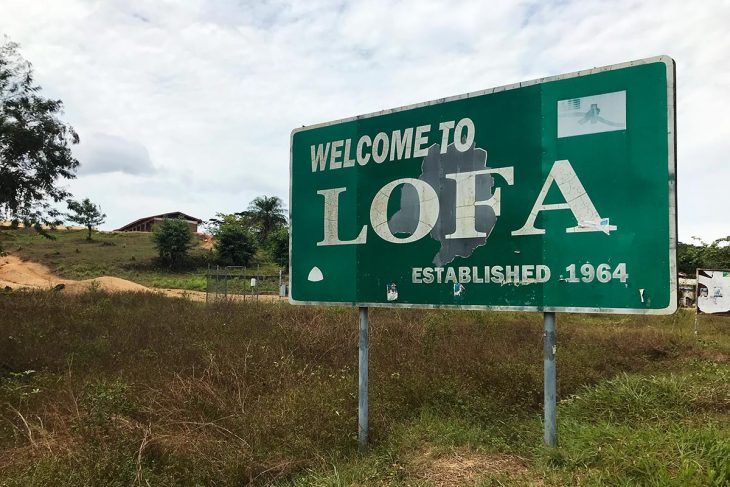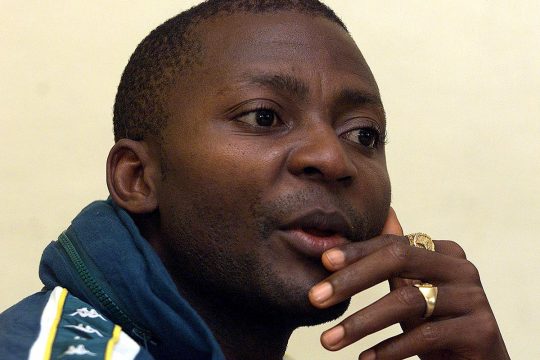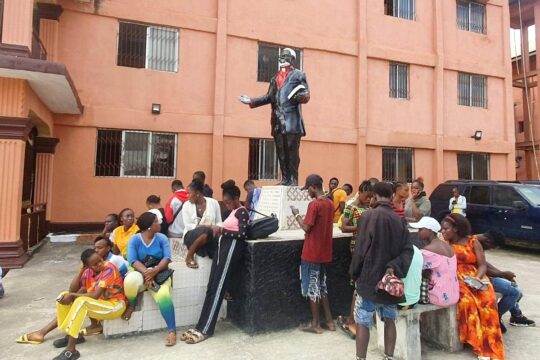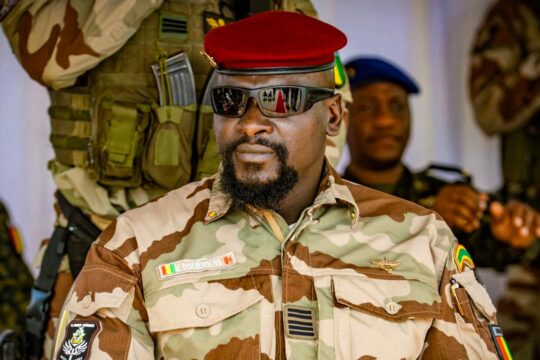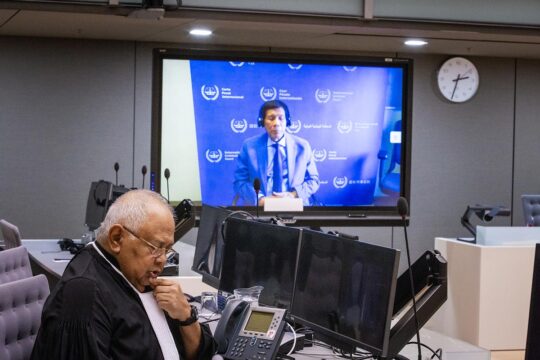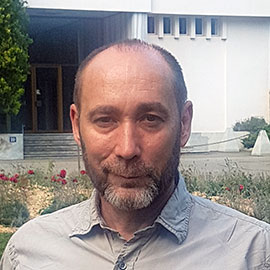"Hello," said the witness in a loud voice as he entered the modest meeting room transformed into a courtroom on the outskirts of Monrovia, the capital of Liberia. His frail body floated in a T-shirt and baggy jeans. "Hello, how are you?" he said with the same candour, once seated, to the prosecutor who introduced himself to the witness. On March 16, "Civilian 36" - his code name in this Finnish court temporarily relocated to Liberia to try the former Sierra Leonean rebel commander Gibril Massaquoi - brought the world of the Lofa County villagers into the world of foreigners’ justice. With him, some 15 inhabitants of this mountainous region, isolated in the far north-east of the country, have come to testify to the horrors that armed groups inflicted on them during the second Liberian civil war, between 1999 and 2003. They come from Kiatahun, Kortohun, Babahun or Kamatahun and Hassala. They all told of the raids carried out by armed men of the Revolutionary United Front (RUF), a rebellion that officially operated from 1991 to 2001 in Sierra Leone, allied to forces loyal to Charles Taylor, a former Liberian warlord who became president of Liberia from 1997 to 2003 before being ousted from power and then tried and sentenced to 50 years in prison by a UN tribunal.
Raids, captures, executions or threats of execution, rapes, looting of meagre possessions and food reserves, beatings, forced labour to carry ammunition or supplies for the fighters: the same modus operandi was relentlessly described by these victims -- an account of the terror that fell upon them on several occasions during the long years of civil war. "After they herded the people, they said they would burn them. And then they killed one in front of us, right besides my uncle’s house," said Civilian 36.
This happened in 2001, said almost all the witnesses. Some of the names of the armed leaders came up regularly: Commander Stanley of the Liberian armed forces, or the infamous Zig Zag Marzah, a Liberian who publicly recounted his barbaric acts and cannibalism before the Special Court for Sierra Leone in 2009, but was never tried. But it is the accused who was obviously the focus of attention. "The guy who did this was called Gibril – Second to God. These were the two names he was using," said Civilian 36, whose prominent eyebrows and very long eyelashes accentuated the depth of his gaze and his eagerness to testify. "Who was Gibril?" asked the prosecutor. "Gibril Massaquoi, commander for the RUF rebels," the witness replied. "He said he was near God."
The battle over dates
"We saw a group of armed men,” he continued. “They captured us. They tied some of my friends. One of them said: we are to kill all of you people. They were some soldiers from Charles Taylor, some from the RUF. They had joined [forces]. They tied my friends one after another, the way they used to carry slaves. They said we should go to Kamatahun. One of them hit me with a gun on my head. On the way, we were all in fear. We reached Kamatahun. They put people in a home. And they set the home ablaze." Remembering this, the witness broke down in tears. "After they burned them down, they gave me ammunition to carry to Popalahun. There we met Zig Zag Marzah. Before me, he executed a man and pulled out his heart and ate it." Zig Zag was not the only one, according to the witness, who engaged in this cannibalistic ritual. "Another one came and said he was Angel Gabriel [the nickname most commonly attributed to Gibril Massaquoi in this trial]. They all contributed to the massacre." According to another witness, “Civilian 50”, it was Angel Gabriel who gave the order to gather the people in that house. "He said: if we cannot kill you, than fire will kill you." However, when questioned by the Finnish police, Civilian 50 never mentioned this ‘Angel’, noted the defense lawyer. And he had named Zig Zag as the person who ordered the house to be burned down.
In this trial, the date on which the crimes were allegedly committed can be decisive for the accused, who is presenting an alibi defence. But in Lofa, the dates quickly became very vague. Civilian 36 and Civilian 50 gave an extraordinarily precise date: Monday 13 August. But the year? That was less certain. Another, “Civilian 18”, gave the exact date of Monday 16 August 2002 to the police, but at the hearing he could not remember. “Civilian 45” gave the same date but did not repeat it before the judges. At the hearing, it was the year 2001, without any other real precision, which now largely dominated the testimonies.
If the facts in Lofa took place in 2001, the defence does not have an airtight alibi. The defence lawyer therefore tirelessly tried to point out inconsistencies between the statements to the police, taken in 2019 or 2020, and what the witnesses told the court.
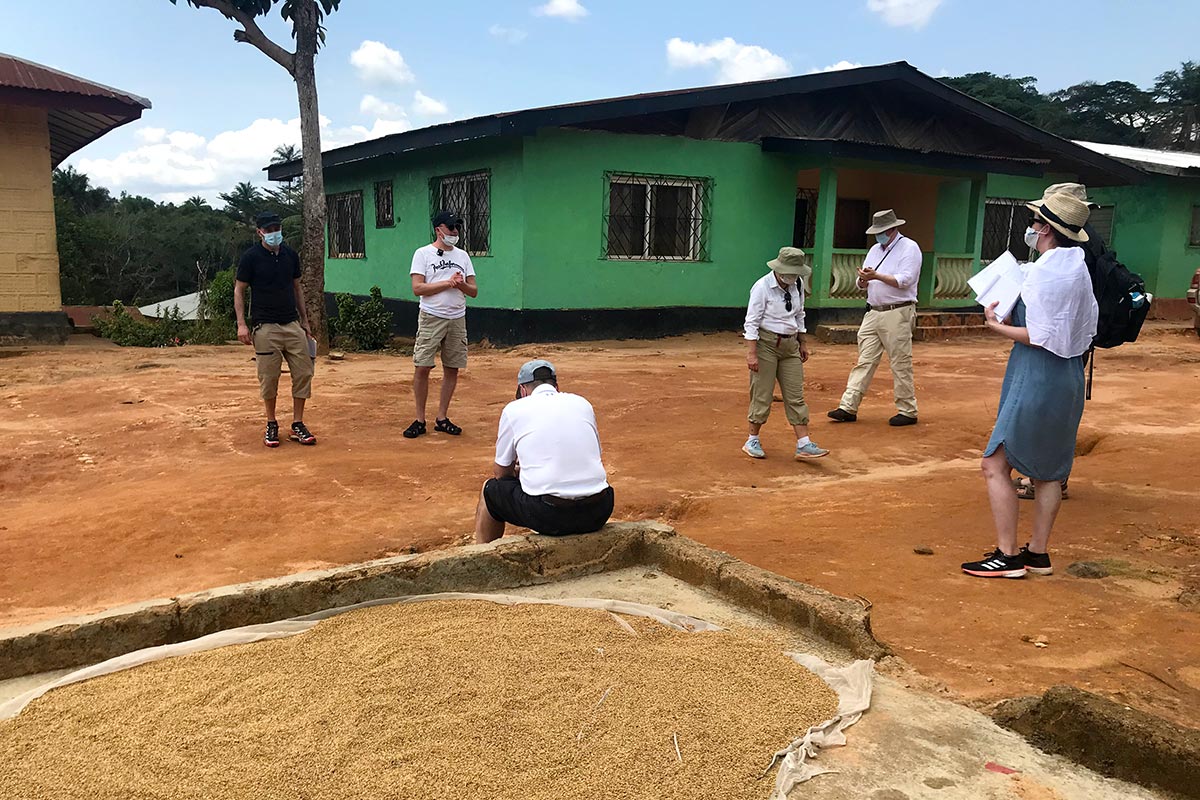
“That’s how the human mind works”
"Government forces came, took us from the bush and brought us in town,” said “Civilian 13”, who was 9 years old in 2001. “All of them were speaking Krio. They had one commander, they used to call him ‘General Gabriel’. He ordered to put fire on the house. They all died. They captured seven women. They tied all of them. General Gabriel said they could take these women and do whatever they wanted to them. He went there too. The next day they were found naked and dead. When we saw them I believe these people had raped them. That’s why they were naked. My very self I saw the bodies the next morning. It’s what put fear in me. For some of them they had used knives. Others had been beaten."
Twenty years later, Civilian 13 estimated that there were about 35 people in the burned house. To the police, he placed the event in 2003. Now he placed it in 2001. He had also said that he only learned about the tragedy at the house in 2004 when he returned to Kamatahun Hassala, which he had fled in 2001. But in court, his testimony was direct and extremely detailed.
"Civilian 16" is the chief of the town of Kamatahun Hassala. He appeared dressed in a traditional cotton ronko with multi-coloured stripes. The absence of eyebrows and high, open arches of the eyebrows that seemed to merge into his forehead gave him a gentle yet slightly dreamy look. He recounted in detail the burning of the house with dozens of inhabitants trapped inside, and then the rape of the seven women. According to him, it was "Angel Gabriel" - a thin, not very tall man wearing a cap and speaking Krio, the lingua franca in Sierra Leone - who gave the order. To the police, he said the massacre took place in September 2002. In court, he said it would have been July/August 2001. "I can't forget it," he said.
"That’s how the human mind works," Civilian 36 replied when he was caught out by the lawyer to explain the changing dates. "We are humans, there are lots of things that play with our minds," warned Civilian 50 before he even began his testimony. "Every living thing that drinks water can forget.”
“Sierra Leonean devils”
All the victims described mixed armed groups of government forces, under the command of Taylor's security chief Benjamin Yeaten, combined with RUF elements. Zig Zag, a subordinate of Yeaten and Taylor, was said by several witnesses to have ordered the immolation of people in this house in Kamatahun Hassala.
But from March 26 onwards, it was the turn of former Liberian fighters to testify against them. And the story that these former Taylor men, allies of the RUF, wanted to put forward was rather different. A story where the perpetrators of the atrocities were always Sierra Leoneans and where their troops - whose abuses were extensively detailed and documented by the Liberian Truth and Reconciliation Commission in 2009 - would have been shocked, they say, that civilians could be targeted in this way.
"We had Sierra Leonen devils, these are those who killed the civilians," said “Soldier 14”, a one-eyed veteran. "When we rushed to Kamatahun, they had already put people in a house and the fire was on. There was nothing we could do. There were even children in. It was on a Friday. It brought us to split because they were RUF and they were killing brutally.” “Soldier 13” supported this same account: "We said: you are not Liberians, why are you killing our people?" The Massaquoi trial then began to look like a strange and disturbing rewriting of history by former members of the notorious anti-terrorist unit or the government army.
Historically implausible statements
In their testimonies, the dozen or so Liberian veterans called to court named many of the top brass of the RUF: its former number 2, Sam "Mosquito" Bockarie (assassinated by Ben Yeaten under Taylor's orders on 5 May 2003), his successor Issa Sesay (arrested in Sierra Leone on 10 March 2003, sentenced to 52 years in prison), Dennis Mingo alias "Superman" (killed in 2001) and even Johnny-Paul Koroma, former leader of a military junta allied to the RUF in 1997-1998 and elected to the post-war Sierra Leonean parliament in 2002 before fleeing to Liberia in January 2003 and allegedly being killed on Taylor's orders in 2003. “Soldier 28” described all these men, as well as Massaquoi, whom he called “Angel Michael”. Soldier 14 added another alias for Massaquoi: "Black Friday Master, because most of the killings he used to do were on Fridays."
In court, Soldier 28 offered his version of history. "Gibril committed the massacre in Kamatahun. When we sent for him, he escaped and we didn’t know where." He also explained that Bockarie, like Koroma, was assassinated because of the atrocities they were committing against the Liberian population. To the police, however, he gave a version much more in line with a historical truth accepted since 2003 about the Bockarie killing. "Taylor got to know that the UN were looking for Bockarie. Because he was afraid that Bockarie could reveal secrets, he told Yeaten (…) to get rid of that guy. So they decided to kill Bockarie at night." This witness had also told the police that he transported Bockarie's body with Massaquoi. But at the hearing, Soldier 28 brushed aside this part of his testimony, while firmly maintaining that "Issa Sesay was there, he carried the body to Sierra Leone".
"When did Sam Bockarie die?" asked the defence lawyer, who has been making hay of such historical inconsistencies. "2001," replied the witness, who was two years wrong. So was “Soldier 09”, who nevertheless offered a very precise account of Bockarie's murder, much more in line with the known facts on the subject. Having also told the police that Gibril Massaquoi was present at the scene of the trap set by Ben Yeaten to eliminate Bockarie, and that the accused had participated in the attack on Côte d'Ivoire in 2002, Soldier 09 waived these two assertions at the hearing, which no history student could possibly retain. Soldier 13 also accused Massaquoi of having ordered the assassination of Koroma, which goes against basic knowledge of the history of the conflict.
The Waterside massacre
The veterans' testimonies offered a strange perspective on known facts. They also came with some risk for the prosecution. Several of them claimed to have witnessed both Massaquoi's alleged crimes in Lofa and those allegedly committed in central Monrovia, in the commercial district of Waterside, an episode heard in detail by the court a few weeks ago.
Soldier 13 was one of those witnesses. "There was a massacre at 6:45pm in one store," he said of the Waterside massacre. "Civilians were looking for food. Salami and Gibril opened fire on them and killed a lot of people. I saw it. I was right there. Massaquoi was in a pick-up and Salami was the one manning the big gun" on the pick-up, he said.
Again, the battle of dates raged on. Soldier 13 told the police that the Waterside massacre took place in 2003, when Charles Taylor "handed over power to Moses Bah", his vice-president. At the hearing, he stated that it was in 2001, the same year as the massacres he said he had witnessed in Lofa. But “Soldier 11” had no hesitation: "When they told Charles Taylor to go, that’s when this happened at Waterside. It was in 2003." He said he saw many of the RUF commanders there, including Sesay (then already in prison in Freetown) and Massaquoi (then in a safe house in Freetown). Later in his testimony, he said he had not seen the latter. And a little later still, he put the accused back at the scene: "Massaquoi said anybody [who takes] things in the store, they should be shot at." The defence asked him to choose:
“Was Massaquoi there or not?”
“Yes,” the witness decided.
“When?”
“In 2003, when people were saying that Charles Taylor had to go. Around July, I think."
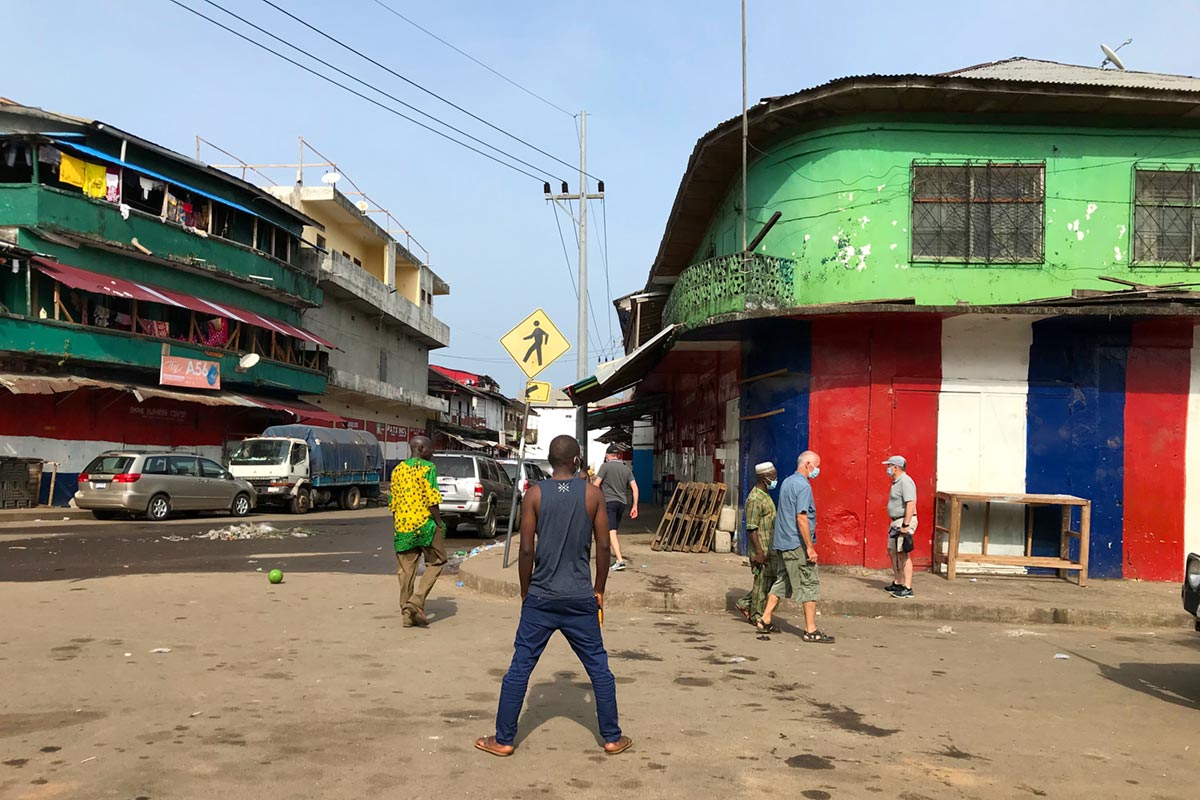
Defence hopes
“Soldier 07” was called “Sweet Candy” during the war. Unlike most of the combatant witnesses, who were junior in rank, “Sweet Candy” was a commander. Several witnesses at the trial were among his men. At the hearing, he dated the incident at Waterside in 2001, and said that, according to him, Massaquoi was in Monrovia after the assassination of Bockarie, before retracting his statement in the face of evidence to the contrary from the defence counsel. Sweet Candy also told the police that at the time of the Waterside massacre, the LURD rebellion "was controlling the bridge" in the city centre. And he had placed the event between May and July 2003. "I cannot recall the year," he said when confronted with his various statements.
The defence took advantage of these testimonies to consolidate its thesis: the Monrovia massacre did take place at the end of the Liberian civil war, between June and July 2003, a period when Massaquoi was officially protected by the UN tribunal in Freetown and could not therefore be committing a massacre in Monrovia. With these ubiquitous combatant witnesses testifying on the crime scenes in Lofa as well as in Monrovia, the defence hopes for even more: that the Monrovia part of the case, by potentially being brought down, ends up contaminating to its advantage the more challenging part of the crimes in Lofa County.


